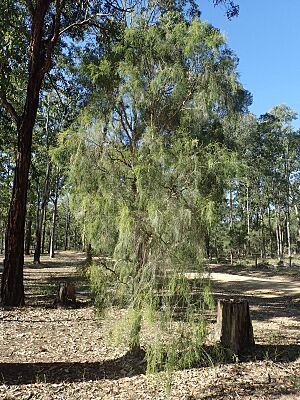Weeping paperbark facts for kids
Quick facts for kids Weeping paperbark |
|
|---|---|
 |
|
| M. irbyana foliage and flowers | |
| Conservation status | |
|
Endangered (NCA)
|
|
| Scientific classification | |
| Genus: |
Melaleuca
|
| Species: |
irbyana
|
| Synonyms | |
|
Melaleuca tamariscina subsp. irbyana (R.T.Baker) Barlow |
|

The Weeping Paperbark (Melaleuca irbyana) is a special plant from the Myrtaceae family, which also includes gum trees. It grows naturally only in New South Wales and Queensland in Australia. This plant is usually a shrub or a small tree. It often grows in groups in areas where the ground stays wet.
The Weeping Paperbark is quite rare. Because of this, it is listed as an endangered species by the governments of New South Wales and Queensland. The forests where it grows are also considered "critically endangered" by the Australian government.
Contents
What Does Weeping Paperbark Look Like?
The Weeping Paperbark is a large shrub or a small tree. It can grow up to 10 meters (about 33 feet) tall. It has thick, soft bark that feels like paper, which is why it's called "paperbark."
Its leaves are small, usually less than 4 millimeters (about 0.16 inches) long and 1 to 2 millimeters (about 0.04 to 0.08 inches) wide. They are oval-shaped and grow close to the branches. The tree has a full, round top and its thin leaves hang down, making it look like it's "weeping."
Flowers and Fruit
The flowers of the Weeping Paperbark are white and have a nice smell. They grow in spikes at the ends of the branches. Each spike is about 14 millimeters (about 0.55 inches) wide and has 3 to 12 flowers.
These flowers bloom between September and January. After the flowers, the tree produces small, round, woody fruits called capsules. Unlike many other plants in the Melaleuca family, the seeds from these fruits do not stay on the tree for a long time.
Where Weeping Paperbark Lives
The Weeping Paperbark is found in only a few specific places in New South Wales and Queensland. In New South Wales, you can find it near towns like Coraki, Casino, and Coutts Crossing. Only two groups of these trees are protected in special nature areas: Warragai Creek Nature Reserve and Bungawalbin National Park.
In Queensland, there are groups of Weeping Paperbark trees near Ipswich, Jimboomba, and Waterford West. These trees like to grow in wet, clay, sandstone, or sandy soils. They often grow together in their own groups or in open forests with eucalypt trees.
Weeping Paperbark's Forest Home
The forests where Weeping Paperbark trees grow are important homes for many plants and animals. These trees often grow alongside different types of eucalypt trees, such as E. crebra and E. tereticornis.
The ground under these trees usually has only a few grasses, sedges, and small plants. This special forest provides a home for the slender milkvine plant (Marsdenia coronata), which is also a threatened species. Many different birds use these trees for shelter and to build their nests. On the ground, fallen logs provide hiding places for reptiles. When it rains, temporary ponds form, which are perfect for frogs and other pond creatures to breed. Animals like koalas, echidnas, and wallabies also live in these forests.
Why Weeping Paperbark Needs Our Help
The Weeping Paperbark is an "endangered" species. This means it is at high risk of disappearing forever. Both the New South Wales Government (under the Biodiversity Conservation Act 2016) and the Queensland Government (under the Nature Conservation Act 1992) have laws to protect it. The Australian government also considers the entire Weeping Paperbark forest to be "critically endangered," which is the highest level of risk. This shows how important it is to protect these special trees and their unique homes.
Related Plants
- Long-leaved paperbark, another type of paperbark tree found in northern Australia, Southeast Asia, New Guinea and the Torres Strait Islands.


